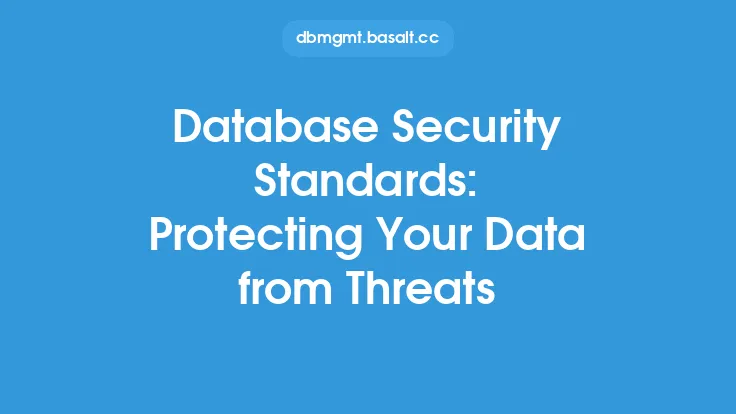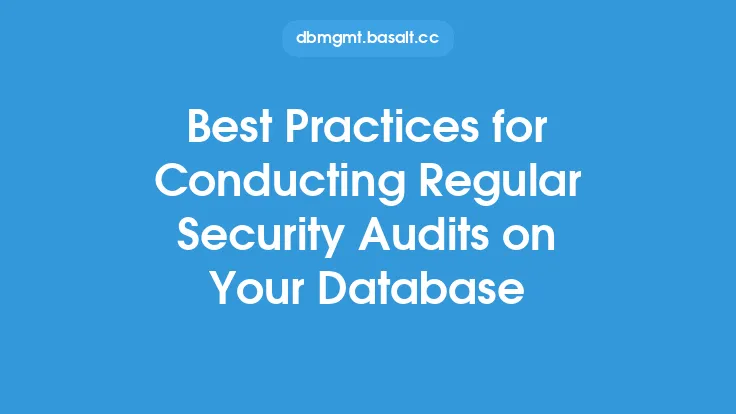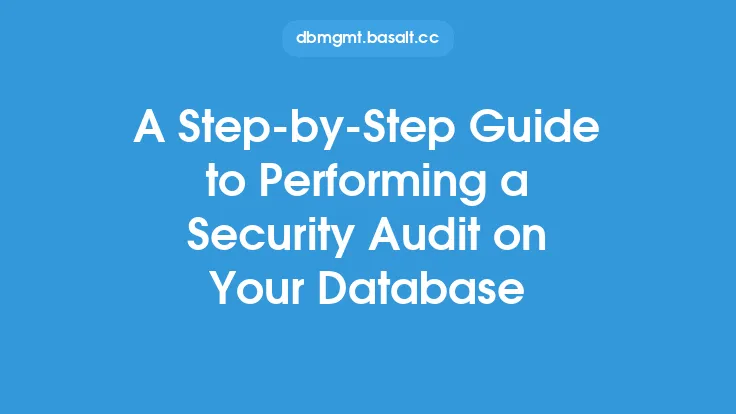Database security is a critical aspect of database configuration, as it ensures the protection of sensitive data from unauthorized access, use, disclosure, disruption, modification, or destruction. A well-designed database security configuration is essential to prevent data breaches, cyber-attacks, and other security threats. In this article, we will delve into the key aspects of database security configuration, discussing the various measures that can be taken to protect your data.
Introduction to Database Security
Database security involves a set of policies, procedures, and technologies designed to protect databases from various types of threats. These threats can be internal or external, intentional or unintentional, and can have severe consequences, including data loss, financial loss, and reputational damage. A robust database security configuration is essential to ensure the confidentiality, integrity, and availability of data.
Authentication and Authorization
Authentication and authorization are two critical components of database security. Authentication refers to the process of verifying the identity of users, while authorization determines the level of access granted to authenticated users. A robust authentication mechanism should be implemented, using techniques such as password hashing, salting, and encryption. Additionally, authorization should be based on a least-privilege model, where users are granted only the necessary privileges to perform their tasks.
Access Control
Access control is a crucial aspect of database security, as it determines who can access the database and what actions they can perform. Access control can be implemented using various techniques, including role-based access control (RBAC), mandatory access control (MAC), and discretionary access control (DAC). RBAC is a popular approach, where users are assigned roles, and each role has a set of privileges associated with it.
Encryption
Encryption is a powerful technique used to protect data from unauthorized access. It involves converting plaintext data into ciphertext, which can only be deciphered with the decryption key. Encryption can be applied to data at rest (stored data) and data in transit (data being transmitted). Common encryption algorithms used in databases include Advanced Encryption Standard (AES) and Transport Layer Security (TLS).
Network Security
Network security is essential to prevent unauthorized access to the database. Firewalls, intrusion detection systems, and virtual private networks (VPNs) can be used to protect the database from external threats. Additionally, network segmentation can be used to isolate the database from other networks, reducing the attack surface.
Auditing and Logging
Auditing and logging are critical components of database security, as they provide a record of all database activities. Auditing involves tracking and monitoring database activities, such as login attempts, queries, and data modifications. Logging involves recording these activities in a log file, which can be used for forensic analysis and compliance purposes.
Secure Configuration
A secure configuration is essential to prevent database vulnerabilities. This includes configuring the database to use secure protocols, such as TLS, and disabling unnecessary features and services. Additionally, the database should be configured to use secure passwords, and password policies should be implemented to ensure strong passwords.
Regular Updates and Patches
Regular updates and patches are essential to prevent database vulnerabilities. Database vendors regularly release updates and patches to fix security vulnerabilities, and these should be applied promptly. Additionally, the database should be configured to receive automatic updates, ensuring that the latest security patches are applied.
Backup and Recovery
Backup and recovery are critical components of database security, as they ensure that data can be recovered in the event of a disaster or data loss. Regular backups should be performed, and these backups should be stored securely, using encryption and access controls. Additionally, a recovery plan should be in place, outlining the procedures for recovering the database in the event of a disaster.
Compliance and Governance
Compliance and governance are essential aspects of database security, as they ensure that the database is operated in accordance with regulatory requirements and organizational policies. Compliance involves adhering to regulatory requirements, such as the General Data Protection Regulation (GDPR) and the Payment Card Industry Data Security Standard (PCI DSS). Governance involves implementing policies and procedures to ensure that the database is operated in a secure and controlled manner.
Best Practices
Best practices are essential to ensure that database security is implemented effectively. These include implementing a defense-in-depth approach, using secure protocols, and configuring the database to use secure passwords. Additionally, regular security audits and risk assessments should be performed to identify vulnerabilities and implement corrective actions.
Conclusion
In conclusion, database security configuration is a critical aspect of database implementation, as it ensures the protection of sensitive data from unauthorized access, use, disclosure, disruption, modification, or destruction. A well-designed database security configuration involves implementing various measures, including authentication and authorization, access control, encryption, network security, auditing and logging, secure configuration, regular updates and patches, backup and recovery, compliance and governance, and best practices. By following these guidelines, organizations can ensure that their databases are secure, reliable, and compliant with regulatory requirements.





